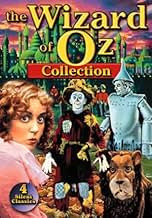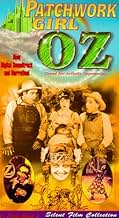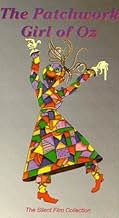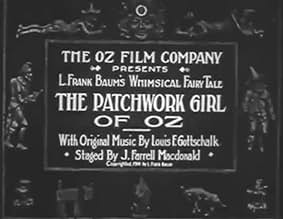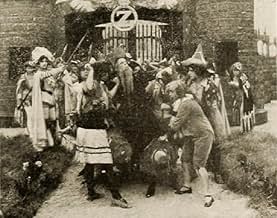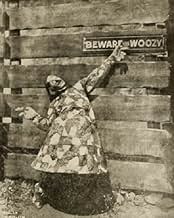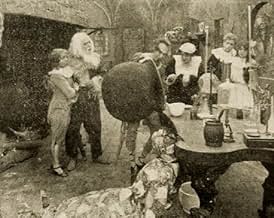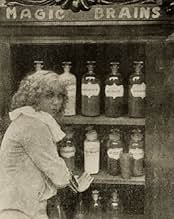PUNTUACIÓN EN IMDb
5,4/10
609
TU PUNTUACIÓN
Añade un argumento en tu idiomaOjo and Unc Nunkie are out of food, so they decide to journey to the Emerald City where they will never starve.Ojo and Unc Nunkie are out of food, so they decide to journey to the Emerald City where they will never starve.Ojo and Unc Nunkie are out of food, so they decide to journey to the Emerald City where they will never starve.
- Dirección
- Guión
- Reparto principal
Leontine Dranet
- Margolotte, his wife, who makes the Patchwork Girl
- (as Haras Dranet)
Richard Rosson
- Danx, a Noble Munchkin
- (as Dick Rosson)
Bert Glennon
- The Scarecrow
- (as Herbert Glennon)
Hal Roach
- The Cowardly Lion
- (as Al Roach)
- …
Dave Anderson
- The Hungry Tiger
- (as Andy Anderson)
Pierre Couderc
- Scraps, the Patchwork Girl
- (as The Marvelous Couderc)
Reseñas destacadas
The enjoyable story and characters in "The Patchwork Girl of Oz" makes it a fun movie to watch, and it is also pretty resourceful for its era. It does have a lot of rough edges and shows some signs of age, but its energy and creativity more than make up for those. As with all of the Oz features made by L. Frank Baum's own studio, it shows his influence in the way that the fantasy world of Oz is brought to life with enthusiasm.
As with most of Baum's Oz stories, it has plenty of oddball characters and offbeat developments. A couple of odd casting choices add to the curious feel, with Pierre Couderc making Scraps look much like a male, and Violet Macmillan making Ojo seem more like a young girl. But they and the rest of the cast give their characters plenty of life, which really is more significant in a movie like this. As in the other Oz movies in the series, Fred Woodward also gets to perform a number of his costumed animal characters.
The story is one of Baum's most creative ones, telling a complex story in which the agendas and motivations of many different characters come into conflict. This adaptation is imaginative in using a lot of different techniques to reproduce the look of the characters, the magical events, and the hectic activity.
Much of it works rather well, and all of it represents a very good attempt for its time. Very few film-makers of the era ever tried to make a full-length picture out of such challenging fantasy material, and even if it has a fair number of rough edges, it remains a worthwhile and entertaining effort.
As with most of Baum's Oz stories, it has plenty of oddball characters and offbeat developments. A couple of odd casting choices add to the curious feel, with Pierre Couderc making Scraps look much like a male, and Violet Macmillan making Ojo seem more like a young girl. But they and the rest of the cast give their characters plenty of life, which really is more significant in a movie like this. As in the other Oz movies in the series, Fred Woodward also gets to perform a number of his costumed animal characters.
The story is one of Baum's most creative ones, telling a complex story in which the agendas and motivations of many different characters come into conflict. This adaptation is imaginative in using a lot of different techniques to reproduce the look of the characters, the magical events, and the hectic activity.
Much of it works rather well, and all of it represents a very good attempt for its time. Very few film-makers of the era ever tried to make a full-length picture out of such challenging fantasy material, and even if it has a fair number of rough edges, it remains a worthwhile and entertaining effort.
A young munchkin named Ojo (played by Violet MacMillan) and her Unc Nunkie decide to set out in search of a better life in the Emerald City of Oz. Along the way, they meet and befriend a magician and his family. The magician has long been at work on perfecting a magic powder of life, his wife having created a patchwork servant girl whom they hope to bring to life. Things go awry when the newly awakened patchwork girl accidentally spills a petrification fluid upon the Magician's wife and his future son in-law as well as Ojo's Unc Nunkie. Now our heroes (the Patchwork Girl, Ojo, the Magician and his daughter) must combine forces in search of the different, rare and hard to obtain ingredients necessary for a spell to undo the petrification process. Many unusual adventures, magical as only the world of Oz can be, await.
This delightful flight of fancy provides viewers with a fun escape from reality. The actors and actresses breathe such a wonderfully vibrant energy into their lively performances that they prove quite a joy to watch. Basically this starts off as a series of individual stories focused on a wide number of colorful characters. By the film's end however, all these different characters and their individual stories seem to merge together into one near epic tale. Of the three 1914 Oz film produced in part by L. Frank Baum himself, this one is clearly the best and most complete adventure story.
This delightful flight of fancy provides viewers with a fun escape from reality. The actors and actresses breathe such a wonderfully vibrant energy into their lively performances that they prove quite a joy to watch. Basically this starts off as a series of individual stories focused on a wide number of colorful characters. By the film's end however, all these different characters and their individual stories seem to merge together into one near epic tale. Of the three 1914 Oz film produced in part by L. Frank Baum himself, this one is clearly the best and most complete adventure story.
A feast of quaint but super-hectic activity, presented before a solidly stationary camera (except for the effective concluding shot), this is a dated and none too interesting attempt by author L. Frank Baum himself to transfer his Oz from the printed page to the cinema. He is let down by the totally unimaginative direction (from well-known character actor J. Farrell MacDonald), the almost entirely stationary camera-work (though there are a couple of clever touches here and there) with its long, boring takes, and the inappropriately over-the-top enthusiasm of almost all the players.
As a curiosity, the movie would make a tolerable two-reeler, but 65 minutes of repetitious jumping, sliding, running, kicking, dancing, climbing, gallivanting, funning and frolicking, is, despite the picturebook tints and novel costumes of its picturebook illustrations brought to life, just far too much of a mediocre thing.
Now, if the highly imaginative original drawings by W.W. Denslow that accompanied Baum's first and most famous venture into the land of Oz, The Wonderful Wizard of Oz (1900), had been brought to life rather than the conventional Victoriana here displayed, the film would doubtless have captured an audience's interest far more than this ultimately wearisome parade. Unfortunately, there was no chance of that happy eventuality. Baum and Denslow had a falling out in 1901 when both men claimed that the instant success of Oz was primarily due to their own input. Therefore it's no surprise that producer Baum made it his business to ensure the movie's visuals were as far removed from Denslow's creations as possible.
As a curiosity, the movie would make a tolerable two-reeler, but 65 minutes of repetitious jumping, sliding, running, kicking, dancing, climbing, gallivanting, funning and frolicking, is, despite the picturebook tints and novel costumes of its picturebook illustrations brought to life, just far too much of a mediocre thing.
Now, if the highly imaginative original drawings by W.W. Denslow that accompanied Baum's first and most famous venture into the land of Oz, The Wonderful Wizard of Oz (1900), had been brought to life rather than the conventional Victoriana here displayed, the film would doubtless have captured an audience's interest far more than this ultimately wearisome parade. Unfortunately, there was no chance of that happy eventuality. Baum and Denslow had a falling out in 1901 when both men claimed that the instant success of Oz was primarily due to their own input. Therefore it's no surprise that producer Baum made it his business to ensure the movie's visuals were as far removed from Denslow's creations as possible.
You really have to look at "The Patchwork Girl of Oz" in context, otherwise you'll just dismiss it as a dull and incomprehensible movie. But, back in 1914, it was a rather impressive tale--but one that even audiences back then probably struggled to understand unless they'd read the Frank Baum story. Heck, I tried watching it was was TOTALLY confused until I read a summary of the story on the internet! That's because the narrative is really scant--with almost no intertitle cards. Instead, it's shown as a series of tenuously connected vignettes which are described on the card and then acted out...as was the style up until about 1914 or a bit later. It comes off almost like a slide show that is acted out for the audience! This certainly is NOT all that entertaining and too often the characters just cavort about aimlessly or do acrobatics instead of acting--and it comes off pretty poorly. BUT, again, it was pretty much the style of the day. The ladies in the film and sets and 'magic' were pretty similar to the work done a decade earlier by the groundbreaking French film maker Georges Méliès. By 1914, these amazing effects and story telling really were a a bit passé--definitely on their way out--which might explain why the film was a critical flop--that, and the fact that the audience probably had no idea what was occurring on screen! Interesting from a historical perspective and having excellent production values for the time, but still very easy to skip unless you adore very early silent films.
As a child, The Patchwork Girl of Oz was my favorite Oz book. This silent film version is a charming look at how Oz was envisioned by it's creator--L. Frank Baum produced the film. The story however does stray from the book and some of the scenes are a bit disjointed. Motion pictures were in their infancy in 1914--most films were stagebound dramas, so to see a fantasy film from this period is unique.
The Patchwork Girl or "Scraps" is played by French acrobat Pierre Couderc. The part where Scraps catches the eye of the Scarecrow is very amusing. Also, the Yoop character is a forerunner to the Winged Monkeys who terrorized Judy Garland 25 years later.
In the video version I saw, the pivotal scene where Scraps is brought to life and tips over the Liquid of Petrification, is missing or destroyed--but the rest of the film is intact however.
The Patchwork Girl or "Scraps" is played by French acrobat Pierre Couderc. The part where Scraps catches the eye of the Scarecrow is very amusing. Also, the Yoop character is a forerunner to the Winged Monkeys who terrorized Judy Garland 25 years later.
In the video version I saw, the pivotal scene where Scraps is brought to life and tips over the Liquid of Petrification, is missing or destroyed--but the rest of the film is intact however.
¿Sabías que...?
- CuriosidadesHarold Lloyd and Hal Roach, who both have minor roles in this film, met on this set in San Diego. Roach was impressed by Lloyd's energy and sought him out when he formed his production company The Rolin Film Company in July 1914 after receiving a small inheritance. Although their association was stormy, their association was ultimately one of the most successful in silent film history.
- PifiasThe character of Ojo is stated several times to be a boy, but is referred to as a girl in one of the dialogue caption cards.
- ConexionesFeatured in American Masters: Harold Lloyd: The Third Genius (1989)
Selecciones populares
Inicia sesión para calificar y añadir a tu lista para recibir recomendaciones personalizadas
- How long is The Patchwork Girl of Oz?Con tecnología de Alexa
Detalles
- Fecha de lanzamiento
- País de origen
- Idiomas
- Títulos en diferentes países
- The Patchwork Girl of Oz
- Localizaciones del rodaje
- Empresa productora
- Ver más compañías en los créditos en IMDbPro
- Duración1 hora 21 minutos
- Color
- Mezcla de sonido
- Relación de aspecto
- 1.33 : 1
Contribuir a esta página
Sugerir un cambio o añadir el contenido que falta

Principal laguna de datos
By what name was La muñeca de trapo de Oz (1914) officially released in Canada in English?
Responde
